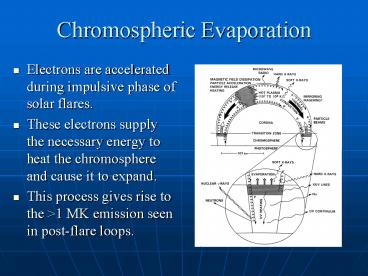Chromospheric Evaporation - PowerPoint PPT Presentation
1 / 18
Title:
Chromospheric Evaporation
Description:
CDS can determine these velocities across a wide range of temperatures. Previous Works ... How is the flares' energy budget divided ? What role do ions play? ... – PowerPoint PPT presentation
Number of Views:80
Avg rating:3.0/5.0
Title: Chromospheric Evaporation
1
Chromospheric Evaporation
- Electrons are accelerated during impulsive phase
of solar flares. - These electrons supply the necessary energy to
heat the chromosphere and cause it to expand. - This process gives rise to the gt1 MK emission
seen in post-flare loops.
2
Cause and Effect
- Evidence for the non-thermal electrons is visible
from HXR emission (gt20 keV). - RHESSI images and spectra can determine
properties of driving electron beam. - The response of the chromosphere is evident from
Doppler shifts in EUV emission lines. - CDS can determine these velocities across a wide
range of temperatures.
3
Previous Works
- Theoretical
- - Neupert (1968)
- - Antiochos Sturrock (1978)
- - Fisher et al. (1984,
- 1985 a, b, c)
- - Mariska, Emslie Li (1989)
- - Abbett Hawley (1999)
- - Allred et al. (2005)
- Observational
- - Antonucci Dennis (1983)
- - Canfield et al. (1987)
- - Zarro Lemen (1988)
- - Czaykowska et al. (1999)
- - Teriaca et al. (2003)
- - Brosius Phillips (2004)
4
SOHO/CDS
- Emission line spectra observed across wide range
of temperatures - He I (0.03 MK)
- O V (0.25 MK)
- Mg X (1.2 MK)
- Fe XVI (2.5 MK)
- Fe XIX (8 MK)
5
Evidence for Explosive Evaporation
- Flux 41010 ergs cm-2 s-1
- ec 20 keV, d 7.3
- He I downflow 35 km s-1
- O V downflow 45 km s-1
- Fe XIX upflow 230 km s-1
6
Evidence for Gentle Evaporation
- Flux 5109 ergs cm-2 s-1
- ec 20 keV, d 5.2
- He I upflow 15 km s-1
- O V upflow 15 km s-1
- Fe XIX - upflow 100 km s-1
7
Velocity against Temperature
8
Summary
- First observations of chromospheric evaporation
from HXR footpoints using RHESSI and SOHO/CDS
(directly comparable with theory). - Observational evidence for both gentle and
explosive evaporation. - References
- Milligan et al. (2006, ApJL, 638, 117)
- Milligan et al. (2006, ApJL, Accepted)
9
Need for Imaging Spectroscopy
- Until now I have investigated only single source
flares - Examples such as this require the individual
spectra from each footpoint
10
Some key remaining questions
- Is evaporation observed in all flares with HXR
emission? - Can we distinguish between thermal and
non-thermal heating processes? - How is the flares energy budget divided ?
- What role do ions play?
- Does the flux of electrons account for all the
material observed in post-flare loop? - In the future, performing joint observations
between RHESSI and Solar-B/EIS will help to
answer many of these questions.
11
Advantages of EIS over CDS
12
CDS emission lines
Stationary Fe XIX
Stationary blueshifted Fe XIX
Fe XII
13
RHESSI Lightcurves
C9.1
M2.2
14
RHESSI Spectra
C9.1
M2.2
15
RHESSI Spectra Images
- Thermal spectrum from hot (107K) plasma within
the loop - Non-thermal spectrum from thick-target collisions
between fast e- (gt20 keV) and dense chromospheric
plasma
16
(No Transcript)
17
Evidence for Upflows
Doppler shifts measured relative to a stationary
component Fe XIX ? v 26015 km/s
18
M2.2 Flare CDS/EIT/GOES































